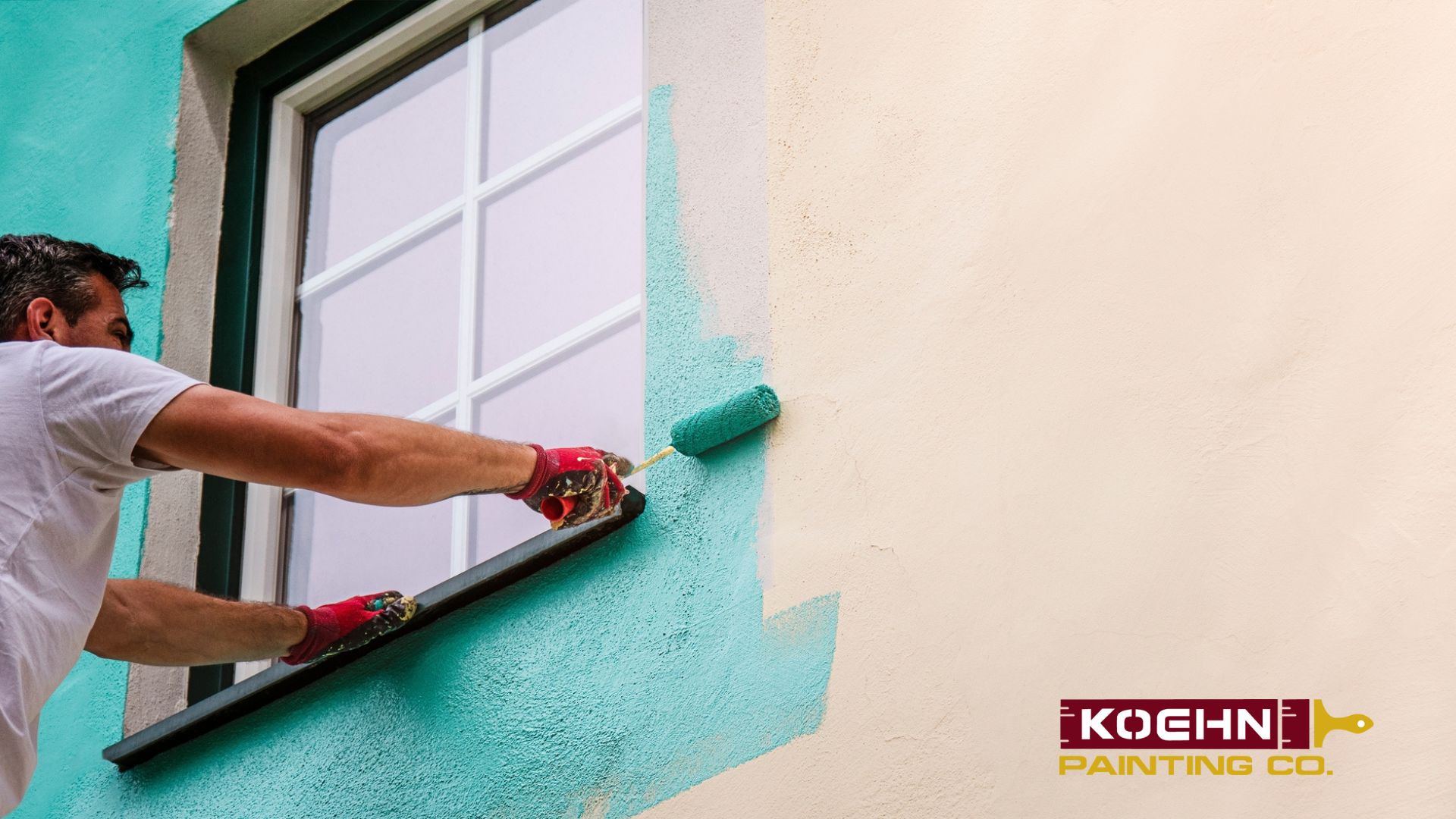Table of Contents
ToggleIs your home’s exterior looking a little tired? Thinking about giving it a new coat of paint? You’re not alone. Many homeowners wonder whether to tackle a DIY painting project or hire professional exterior painters. In this guide, we’ll share tips and tricks from the best exterior painters in Wichita, KS, to help you make the right choice.
Expert Tips on Exterior House Painting

Whether you’re ready to roll up your sleeves for a DIY exterior house painting project or considering hiring professionals, you want your exterior to turn out amazing.
Learning from the best exterior painters can help you achieve a flawless finish that looks stunning and lasts. Check out these expert tips to help you determine the best approach for your painting plan.
1. Get Those Surfaces Spotless
Before you start painting the exterior, make sure you clean the surfaces thoroughly. Using a power washer is the best way to remove dirt, grime, and any loose paint. This will help the new paint stick properly and last longer. When power washing, keep the pressure between 1,500 and 2,500 PSI – any higher, you could damage the surface. Hold the nozzle at a 45-degree angle and keep it at least 12 inches away.
Sweep it back and forth to cover everything evenly. For tight spaces or delicate areas, use a garden hose with a scrub brush instead. If you’re not comfortable using a power washer, rent one or hire a pro for Pressure Washing to do a thorough and safe job.
2. Inspect and Repair Before Painting
Before you start painting the outside of your home, check for problems. Look for cracks, peeling, blistering, or other paint damage. In older homes, be extra careful with lead-based paint, which needs special handling because it’s toxic.
Fix any issues you find. Fill cracks with the right filler, sand down rough spots to smooth the surface, and replace any damaged siding.
3. Use Primer
Primer allows the paint to stick better and last longer. It creates a uniform base that the paint can adhere to, especially on bare wood or unpainted areas. This step is important to prevent the paint from peeling or blistering, which can happen if the paint is applied directly to a porous or uneven surface.
Use a high-quality primer that works well with the topcoat paint you’ve chosen. And before applying primer, make sure to thoroughly clean and sand the surface. Skipping the primer step can lead to problems down the line, so take the time to do it right.
4. Exterior Paint? Choose the Best
When choosing paint for the outside of your home, it’s important to go with high-quality, weather-resistant options that can handle your local climate. Look for paints that protect against UV rays to prevent fading and resist mildew.
Do not underestimate the choice of colors. Choose the ones that complement your home’s style and the surrounding area. If you live in a historic neighborhood, check with local guidelines to make sure your color choices follow any rules or suggestions.
5. Paint in Ideal Conditions
For the best results, it’s important to paint your exterior surfaces in the right weather conditions. Avoid painting when it’s too hot or too cold – temperatures below 50°F or above 85°F can prevent the paint from sticking properly and drying evenly. High humidity can also drive the paint to dry too slowly, leading to issues like sagging or blistering.
Instead, choose dry, mild days to do your painting. The ideal time is during the cooler parts of the day, like the morning or late afternoon.
6. Safety First: Lead-Based Paint and Protective Gear
If you’re working on homes built before 1978 be careful of lead-based paint. This stuff can be really dangerous if it starts to break down. It can create toxic dust that you don’t want to breathe in or get on your skin.
The smart thing to do is get a professional to check for lead first. They can test the paint and tell you if it’s safe to work with.
And when you’re doing the painting, wear a good-quality mask to keep the dust out of your lungs. Gloves will stop it from getting on your skin. And wear safety goggles to keep it out of your eyes.
7. Applying Paint Tools and Techniques
High-quality brushes are ideal for detailed work and cutting in around edges, while rollers are great for efficiently covering large, flat surfaces. A paint sprayer can be very effective for a smooth, even coat on large areas, especially on textured surfaces or intricate details.
Apply the paint in thin, even coats to avoid drips and ensure a smooth finish. Always start from the top and work your way down to catch any potential drips and allow for proper blending.
8. Regular Maintenance: How Long Does Exterior Paint Last?
Typically, a house can go 5 to 10 years without needing a new coat of paint, depending on the quality of the original paint and where your home is located.
Here’s a quick guide on how often different siding materials need repainting:
- Metal Siding: Repaint metal sidings, including aluminum and steel, every 10 years. With proper care, metal can last 40 to 70 years.
- Wood Siding: Wood needs more frequent attention – repaint every 3 to 7 years to protect against rot and weather damage.
- Stucco: Repaint stucco surfaces every 5 to 10 years. The exact timeline depends on factors like climate and the previous paint quality.
- Brick: Brick exteriors should be repainted every 3 to 5 years. Be extra careful to avoid trapping moisture, which can damage the brick.
The secret is regular inspections and maintenance, along with quick fixes, to get the most out of your home’s exterior paint job.
9. Environmental Protection and Other Essential Precautions
Fire-retardant coatings: If you live in an area prone to wildfires, apply fire-retardant coatings to your home’s exterior. These coatings help prevent the ignition of surfaces exposed to embers and direct flames. Choose non-combustible siding materials like fiber cement, metal, or treated wood. Another tip? Clear out any flammable vegetation around your property. This creates a defensible space that can really help in a wildfire.
Environmental responsibility: Be sure to get rid of old paint, solvents, and other materials properly, following local rules and regulations.
Never wash your brushes, rollers, or equipment where the dirty water can flow into storm drains. That can pollute rivers, lakes, and other water sources. Instead, clean your tools in an area where the waste can be properly handled and disposed of.
Ventilation: When painting indoors or in enclosed spaces, open windows and doors to improve airflow. Use exhaust fans to help remove fumes from the work area. For added protection, wear a respirator designed for paint fumes. Proper ventilation not only safeguards your health but also helps the paint dry more evenly, resulting in a better finish.
10. Hiring Professional Exterior Painters: When You Need Them
Before tackling an exterior painting project yourself, ask yourself these questions:
- Do I have the time to complete the project properly?
- Can I prepare the surfaces correctly to ensure the paint lasts?
- Do I have the right tools and equipment for a professional finish?
- Am I confident in choosing the best paints and primers for my home?
- How large and tall are the areas I need to paint? Will I need ladders or scaffolding?
Painting the outside of your home is a major task. If you’re unsure about any of these, hiring professional painters may be the best choice.
Experts like the team at Koehn Painting have the skills and equipment to handle even the toughest projects. They know how to prepare surfaces properly, select the right paints, and apply them for a long-lasting, beautiful finish. Trying to do it yourself can lead to problems like poor surface prep, causing the paint to fail early.
For bigger renovations, especially with old lead-based paint, you may need permits and need to follow special safety standards. Professional painters like Koehn are experienced with these complexities, so you can relax knowing the job will be done safely and legally.
Discover the Koehn Painting difference – contact us today for a free estimate. You can also reach out if you need help finding the best painting contractor for your residential or commercial painting needs.
Exterior Painting: When Not To Paint Outside

Did you miss our article about the best time of year to paint your exterior? Timing is everything when it comes to exterior house painting, and knowing when not to paint outside can save you a lot of trouble.
June is an awesome month to get those exterior painting projects done; all the best exterior painters know this. The weather is usually just right, with temperatures between 50°F and 85°F—perfect for both water-based and oil-based paints. The humidity is typically between 40% and 70%, which helps the paint dry and cure properly.
And don’t forget to check the forecast; you want to avoid any rain for at least four to eight hours after painting to prevent problems like cracking, peeling, and mildew.
However, it’s not just about avoiding rain. Consumer Reports emphasizes the importance of considering wind conditions. Painting on windy days can blow dirt and debris onto your fresh paint, leading to an uneven finish and potential paint failure. Additionally, high winds can cause the paint to dry too quickly, preventing it from properly bonding to the surface.
Temperature extremes are also a big no-no for exterior house painting. Painting when it’s too hot can cause the paint to blister and peel, while painting in cold weather can slow down drying times, leading to a subpar finish.
Timing isn’t just about the right season but also the right time of day. Avoid painting in direct sunlight, as this can cause the paint to dry too quickly. Instead, follow the shade around your house to maintain an even temperature on the surfaces you’re painting.
Additionally, the exterior paint color you choose can affect the timing and success of your project. For example, darker colors tend to absorb more heat, which can cause the paint to dry too quickly and increase the risk of blistering, especially in hot weather. Lighter colors reflect more sunlight, reducing heat absorption and helping to maintain a consistent drying process. Finally, when selecting your paint color, consider how it will look under different lighting conditions throughout the day.
Looking for the Best Exterior Painters? Choose Koehn Painting

For more detailed advice and expert recommendations, always refer to trusted sources like the Koehn Painting blog. The team provides insider tips from the best exterior painters to help you make the right decisions and avoid common pitfalls.
Koehn Painting provides a full suite of exterior painting services. Our experts can help you choose the perfect colors, properly prepare surfaces, and apply the paint using the most sought-after materials and the latest techniques.
Time for a change? Contact Koehn Painting for a free estimate and let’s give your home’s exterior a new look.





